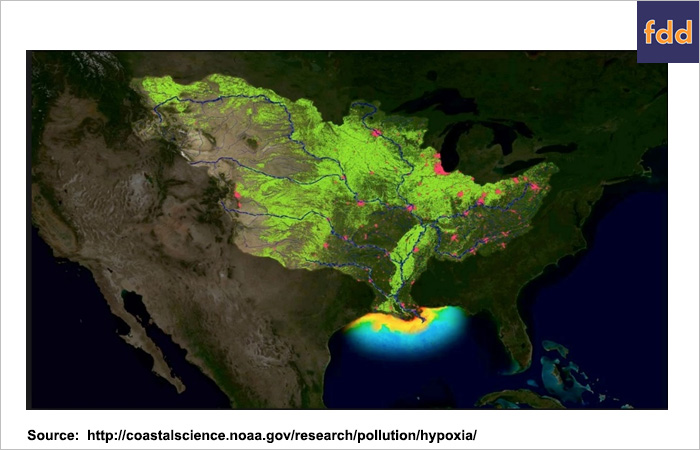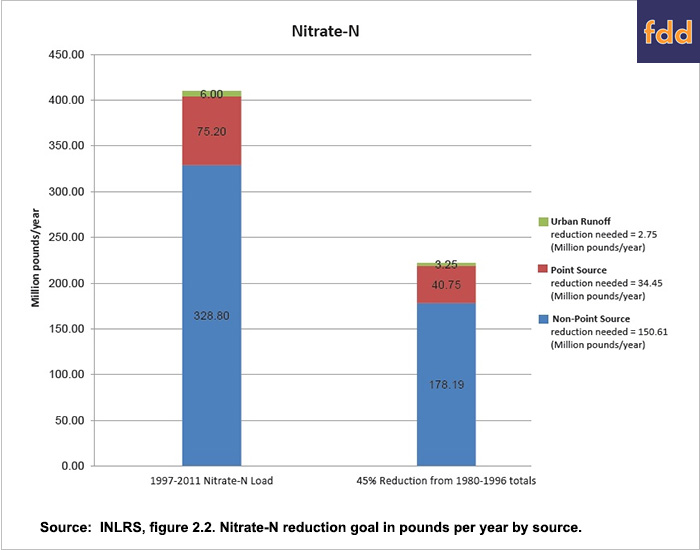Dead Zones & Drinking Water, Part 1: RCPP and Review
On Friday, February 12, 2016, USDA announced that a coalition of partners led by the Illinois Corn Growers, and including the University of Illinois, had been awarded a $5.3 million Regional Conservation Partnership Program (RCPP) agreement to implement the Precision Conservation Management effort to help address nutrient loss and water quality. The award represents the latest effort to help Illinois farmers reduce nutrient losses and improve water quality. This article begins a series discussing the nutrient loss and water quality issues following the Illinois Farm Economics Summit (IFES) discussion in December 2015 (see farmdoc daily, December 29, 2015).
Nutrient Loss & Water Quality: A Review
The issue is nutrient-impacted water quality in the Mississippi River Basin. It includes a significant focus on nutrients lost from farm fields and, in particular, nitrogen fertilizer. Nutrients that feed growing crops cause problems in water, from local drinking water supplies to the hypoxic or dead zone in the Gulf of Mexico. When deposited by the Mississippi River, they feed algae that live in the Gulf’s warm waters. These algae can overtake an area and when they die the decomposition consumes oxygen, depleting the water of its supply and chasing out shrimp, fish and other aquatic species (Petrolia and Gowda 2006). Left behind is a hypoxic or dead zone in the water. In 2014, the National Oceanic and Atmospheric Administration (NOAA) estimated the dead zone to be 5,052 square miles, or about the size of Connecticut.

According to the Illinois Nutrient Loss Reduction Strategy (INLRS), the baseline estimate for agriculture’s share of the nitrogen loss in Illinois is 329 million pounds per year, roughly 80 percent of the total lost. Illinois is significant to the Gulf of Mexico Hypoxia issue because of its farmland footprint: a total of nearly 22 million acres of corn and soybean production, 9.7 million of it tile-drained (David, et al. 2015). According to USDA’s National Agricultural Statistics Service (NASS), there are 26.9 million total acres farmed in Illinois. Illinois has the most tile-drained acres among its Midwest neighbors, followed by Indiana’s 8.1 million, Iowa’s 7.8 million and Ohio’s 7.4 million acres (Petrolia and Gowda 2006). If the challenge looks large in Illinois, it may seem overwhelming for the entire Mississippi River Basin (MRB). USDA’s Economic Research Service (ERS) estimates there are 242 million acres planted to the major commodities and that nitrogen is applied to 69 percent (167 million) of the acres (Ribaudo, et al 2011). Scientists have estimated a total of 49.4 million tile-drained acres in the entire MRB (Royer, David and Gentry 2006). Others have estimated as much as 70 million drained acres (Petrolia and Gowda 2006). The MRB contributes 90 percent of the fresh water to the Gulf and drains 41 percent of the continental United States; 90 percent of the nitrate that gets into the Mississippi River comes from non-point sources, 74 percent of which are agricultural (Petrolia and Gowda 2006).

The Des Moines Water Works (DMWW) lawsuit filed in March 2015 against three Iowa drainage districts may well bring the nutrient loss issue much closer to home. The lawsuit challenges the general exemption for agricultural storm water discharges under the Clean Water Act, as well as raising nuisance and other claims for damages due to cleaning nitrates out of the Des Moines drinking water supply (see Policy Matters, February 3, 2015). The lawsuit focuses on nitrogen losses from tile-drained farmlands, but resolution is not likely to be accomplished quickly.
RCPP and Precision Conservation Management
The Regional Conservation Partnership Program (RCPP) is a new conservation program created by the Agricultural Act of 2014. It consolidated several program authorities and makes use of funds and authorities from existing conservation programs such as the Environmental Quality Incentives Program (EQIP), the Agricultural Conservation Easement Program (ACEP) and the Conservation Stewardship Program (CSP). The program also requires contributions from private partners to match the USDA investment. Overall, the goal is to coordinate conservation efforts to address significant natural resource challenges on a regional scale (see farmdoc daily, May 29, 2014). USDA designated the Mississippi River Basin as a Critical Conservation Area under the statute with a focus on addressing water quality. RCPP represents a significant shift in conservation policy, moving from one program-one farm practices to a coordinated, regional approach across multiple farms (see also Policy Matters, July 24, 2014).
One of the big challenges with conservation efforts to address nutrient loss involves managing additional risks, complexities and costs. Cover crops offer a great example, particularly those that overwinter such as cereal rye. They are often sown around harvest. If successfully established, these overwintering cover crops would initially grow after the cash crop is harvested and before going dormant in the winter. They are considered ideal for reducing nitrate losses in tiled soils largely because they grow quickly as it warms in the spring. The cover crop has to be terminated at an optimal time to avoid interference with cash crop planting. Cover crops cost money, they add management complexity and risk, particularly in the already tight windows for spring planting and fertilizer application. Balancing the risks, costs and benefits present real management challenges for farmers. Initial research indicates that precision technology could be effective for conservation and would seem to be necessary for tackling the nutrient loss challenge (Tomer, et al 2015).
To that end, Precision Conservation Management is designed to be an innovative service program that will make use of farm business and financial practices in combination with developing precision technology and data management to help farmers manage, adopt and adapt conservation practices and improve on-farm decision-making. The goal is to integrate conservation into the commodity crop operations through financial impact analysis of conservation practices, technical assistance, financial assistance, data assessment tools and similar precision technology specifically applied to conservation. The effort seeks to enhance the effectiveness of conservation for the farm operation, while helping reduce complexity and manage the risks associated with practices. Precision Conservation Management will work through CSP for financial assistance and with field-by-field management to increase conservation adoption in the region, approaching conservation from the perspective of the Midwest farmer to benefit the farmer, the environment and local communities.
Dead Zones & Drinking Water Series
This series of articles will analyze various nutrient loss and water quality issues for agriculture. It will review research on issues such as nutrient loss, drainage and cover crops. The series will also explore conservation policy and analyze legal questions surrounding the DMWW lawsuit. It will not seek to assess blame. The bottom line is that farmers use nutrients to grow crops to feed a world of demand but everyone loses when those nutrients leave the field and end up in the water. We need food and clean drinking water; we all benefit from healthy water systems and productive farming. The search for solutions is vast, necessary and daunting, but it is underway.
References
Coppess, J. "IFES 2015: Dead Zones & Drinking Water: Farming's Nutrient Loss Challenge." farmdoc daily, Department of Agricultural and Consumer Economics, University of Illinois at Urbana-Champaign, December 29, 2015.
Coppess, J., and T. Kuethe. "The Regional Conservation Partnership Program in the Farm Bill." farmdoc daily (4):99, Department of Agricultural and Consumer Economics, University of Illinois at Urbana-Champaign, May 29, 2014.
Coppess, J. "Environmental Regulation of Agriculture: The Des Moines Water Works Issue." Policy Matters, Department of Agricultural and Consumer Economics, University of Illinois at Urbana-Champaign, February 3, 2015. http://policymatters.illinois.edu/environmental-regulation-of-agriculture-the-des-moines-water-works-issue/
Coppess, J. "A Brief History of Farm Conservation Policy." Policy Matters, Department of Agricultural and Consumer Economics, University of Illinois at Urbana-Champaign, July 24, 2014. http://policymatters.illinois.edu/a-brief-history-of-farm-conservation-policy/
Daniel R. Petrolia and Prasanna H. Gowda, "Missing the Boat: Midwest Farm Drainage and Gulf of Mexico Hypoxia," Review of Agricultural Economics, Vol. 28, No 2, pp. 240-53 (2006).
Marc Ribaudo, Jorge Delgado, LeRoy Hansen, Michael Livingston, Roberto Mosheim, and James Williamson, "Nitrogen in Agricultural Systems: Implications for Conservation Policy," ERR-127, U.S. Dept. of Agriculture, Econ. Res. Serv. (Sept. 2011). http://www.ers.usda.gov/publications/err-economic-research-report/err127.aspx
Mark David, Gregory McIsaac, Gary Schnitkey, George Czapar and Corey Mitchell, "Science Assessment," in Illinois Nutrient Loss Reduction Strategy, Chapter 3. http://www.epa.illinois.gov/Assets/iepa/water-quality/watershed-management/nlrs/nlrs-final-revised-083115.pdf
M.D. Tomer, S.A. Porter, K.M.B. Boomer, D.E. James, J.A. Kostel, M.J. Helmers, T.M. Isenhart, and E. McLellan, "Agricultural Conservation Planning Framework: 1. Developing Multipractice Watershed Planning Scenarios and Assessing Nutrient Reduction Potential," J. of Enviro. Qual.., 44:754-767 (2015).
Todd Royer, Mark B. David, and Lowell E. Gentry, "Timing of Riverine Export of Nitrate and Phosphorous from Agricultural Watersheds in Illinois: Implications for Reducing Nutrient Loading to the Mississippi River," Environ. Sci. & Technol., vol. 40, no. 30, pp. 4126-4131 (2006).
USDA Natural Resources Conservation Service. 2016 RCPP Projects by State. http://www.nrcs.usda.gov/wps/portal/nrcs/detail/national/programs/farmbill/rcpp/?cid=nrcseprd598407
Disclaimer: We request all readers, electronic media and others follow our citation guidelines when re-posting articles from farmdoc daily. Guidelines are available here. The farmdoc daily website falls under University of Illinois copyright and intellectual property rights. For a detailed statement, please see the University of Illinois Copyright Information and Policies here.







